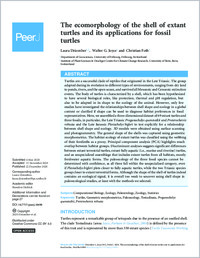The ecomorphology of the shell of extant turtles and its applications for fossil turtles
DOKPE
- Dziomber, Ilya Department of Geosciences, University of Fribourg, Fribourg, Switzerland / Institute of Plant Sciences & Oeschger Centre for Climate Change Research, University of Bern, Bern, Switzerland
- Joyce, Walter G. Department of Geosciences, University of Fribourg, Fribourg, Switzerland
- Foth, Christian Department of Geosciences, University of Fribourg, Fribourg, Switzerland
- 2020
Published in:
- PeerJ. - 2020, vol. 8, p. e10490
Turtles
Geometric morphometrics
Paleoecology
Testudinata
Proganochelys quenstedtii
Proterochersis robusta
English
Turtles are a successful clade of reptiles that originated in the Late Triassic. The group adapted during its evolution to different types of environments, ranging from dry land to ponds, rivers, and the open ocean, and survived all Mesozoic and Cenozoic extinction events. The body of turtles is characterized by a shell, which has been hypothesized to have several biological roles, like protection, thermal and pH regulation, but also to be adapted in its shape to the ecology of the animal. However, only few studies have investigated the relationships between shell shape and ecology in a global context or clarified if shape can be used to diagnose habitat preferences in fossil representatives. Here, we assembled a three-dimensional dataset of 69 extant turtles and three fossils, in particular, the Late Triassic Proganochelys quenstedtii and Proterochersis robusta and the Late Jurassic Plesiochelys bigleri to test explicitly for a relationship between shell shape and ecology. 3D models were obtained using surface scanning and photogrammetry. The general shape of the shells was captured using geometric morphometrics. The habitat ecology of extant turtles was classified using the webbing of their forelimbs as a proxy. Principal component analysis (PCA) highlights much overlap between habitat groups. Discriminant analyses suggests significant differences between extant terrestrial turtles, extant fully aquatic (i.e., marine and riverine) turtles, and an unspecialized assemblage that includes extant turtles from all habitats, mostly freshwater aquatic forms. The paleoecology of the three fossil species cannot be determined with confidence, as all three fall within the unspecialized category, even if Plesiochelys bigleri plots closer to fully aquatic turtles, while the two Triassic species group closer to extant terrestrial forms. Although the shape of the shell of turtles indeed contains an ecological signal, it is overall too weak to uncover using shell shape in paleoecological studies, at least with the methods we selected.
- Faculty
- Faculté des sciences et de médecine
- Department
- Département de Géosciences
- Language
-
- English
- Classification
- Biology, life sciences
- License
- Open access status
- gold
- Identifiers
- Persistent URL
- https://folia.unifr.ch/unifr/documents/312365
Statistics
Document views: 105
File downloads:
- Dziomber_etal_2020_Turtle_Shell_Geometry: 215
